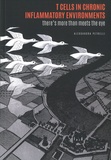T Cells in chronic inflammatory environments
There's more than meets the eye
Summary
Chronic inflammatory diseases include a variety of organ-specific immune-mediated diseases characterized by a chronic and recurrent state of local inflammation. T cells are essential component of the adaptive immunity, whose imbalanced actions contribute to determine the pathology of chronic inflammatory diseases. Aim of this thesis is to dissect how the local inflammatory milieu influences T cell development and dynamics in chronic inflammatory diseases, with a particular focus on Juvenile Idiopathic Arthritis (JIA). In Chapter 1 different subsets of the adaptive immune response known to take part in the pathogenesis and maintenance of chronic inflammatory diseases are described, as well as recently identified T cell subsets, such as the so called ‘exhausted’ T cells and tissue resident memory (TRM) cells, still unexplored in this context. In Chapter 2 the current knowledge on the role of CD8 T cells in autoimmune inflammation is extensively reviewed, highlighting their crucial contribution to tissue damage and local inflammation. Chapter 3 demonstrates that the resistance to suppression occurring at the site of chronic inflammation is an intrinsic feature of T cells rather than induced by other cell subsets. Of note, a different mechanism underlying the resistant phenotype was shown for the two major T cell subsets: indeed, unlike CD4 T cells, resistance of CD8 T cells to suppression is maintained by autocrine release of IFN-, indicating a potential therapeutic value of blocking IFN- to restore immune regulation in JIA. In Chapter 4 a specific subset of CD8 T cells found in the synovial fluid of JIA patients is extensively characterized and we show that this overrepresented PD-1+CD8 T cell subset has the phenotype of metabolically active, clonally expanding effectors, with no sign of exhaustion. This unique subset was enriched with the TRM cell transcriptional profile, and PD-1-expressing TRM cells were found increased also in other human inflamed tissues, such as the gut of patients with inflammatory bowel diseases (IBD) and the skin of patients with atopic dermatitis (AT). These data indicate that local chronic inflammation drives the induction of a unique subset of CD8 T cells endowed with potential detrimental properties in the context of chronic inflammatory diseases and might be an interesting target for therapy. Chapter 5 elucidates the mechanisms underlying the TH1 cell enrichment observed in the synovial fluid of JIA patients. Despite the previously described contrasting, i.e. pro and anti-inflammatory, effects of IL-27, it was found that the elevated levels of IL-27 observed in the synovial fluid of JIA patients sustain TH1 cell maintenance and survival at this site, suggesting that this cytokine may be a promising therapeutic target for JIA. In Chapter 6 a patient-tailored protocol for the generation of donor-specific type 1 regulatory T cells (Tr1) is developed to be infused in living donor kidney transplanted patients –characterized by a state of chronic peripheral inflammation- to obtain long-term acceptance of the graft. Here, it is discussed that, for clinical translation of basic discoveries, it is crucial to carefully screen the immune system of patients before enrollment in cell therapy clinical trials, in order to minimize possible negative outcomes and ultimately safeguard patient health. In line with this need, in Chapter 7 we propose to reconsider the figure of translational scientist by developing experts of the translational medicine continuum, i.e. Translational Medicine Professional (TMPs), starting from education and training. Such TMPs should be endowed with specific skills and be integral part of a worldwide network of experts, a platform designed to connect, interface and share ideas, data and tools, with the final goal to develop clinically applicable products and technologies. In Chapter 8 I discuss how different subsets of the adaptive immune system develop and interact at the target site of inflammation of human chronic inflammatory diseases. Candidate checkpoints of the chronic inflammatory cascade were identified and proposed as potential therapeutic targets in human chronic inflammatory diseases. Also the importance of investigating shared as well as disease-specific mechanisms in order to develop suitable therapeutic interventions and ultimately improve patient health is highlighted.
